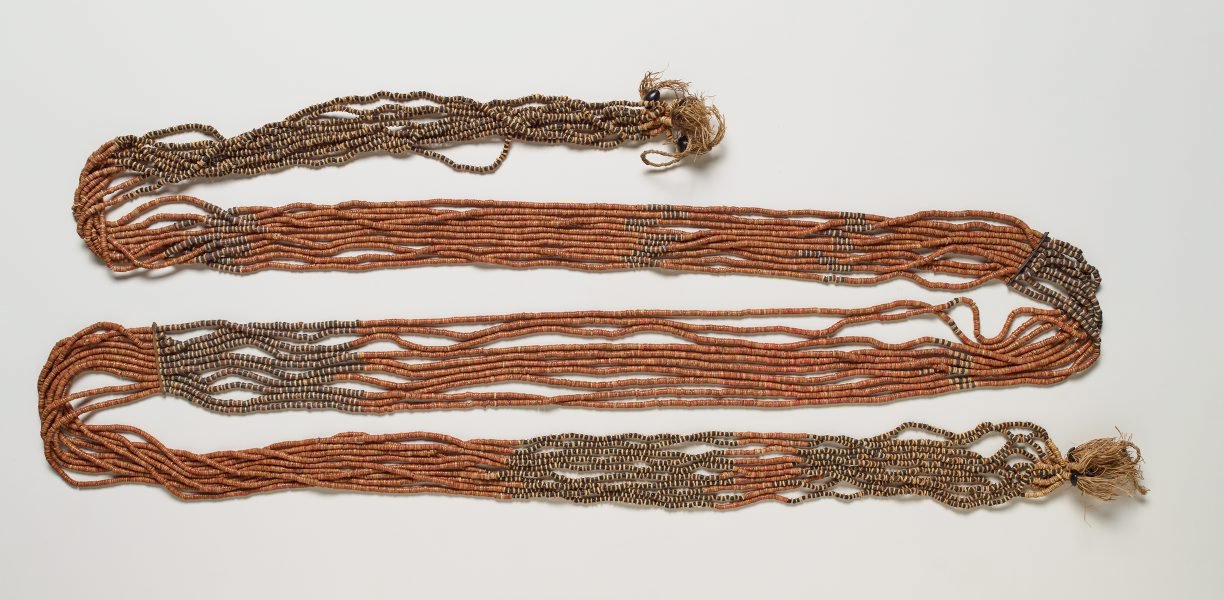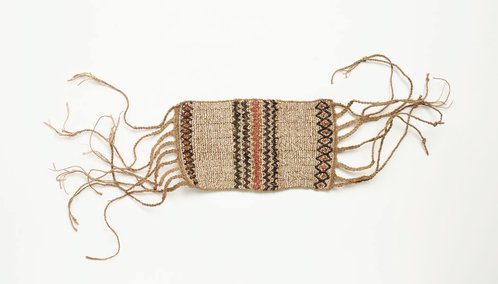Title
Tafuli'ae (shell wealth)
late 19th century-early 20th century
Artist
-
Details
- Place where the work was made
-
Malaita
→
Malaita Province
→
Solomon Islands
- Cultural origin
- Langalanga people
- Date
- late 19th century-early 20th century
- Media category
- Ceremonial object
- Materials used
- ten lengths of shell beads consisting of red-lipped oyster shell (Chana pacifica) disks, ridged white cockle shell (Anadara granosa) disks, black mussel shell (Atrina vexillum) disks, black 'fulu' seeds, two tortoise shell spacers, 8 black seed pods, plant fibre string
- Dimensions
- 354.5 cm length (approx.), two arms lengths (ro abala); 6.5 cm width (approx.)
- Credit
- Purchased under the terms of the Florence Turner Blake Bequest 2015
- Location
- Not on display
- Accession number
- 261.2015
- Copyright
- Artist information
-
Langalanga people
Works in the collection
- Share
-
-
About
Malaita is one of a group of islands that forms the Solomon chain, which lies southeast of the island of New Guinea. Large reefs and lagoons are found on both sides of Malaita. The Langalanga, who live mainly on artificial or semi-artificial islets in a lagoon on the west coast, produce various kinds of shell 'money', which is distributed and exchanged throughout the island.
Four species of marine shells are sourced to produce the red, white and black beads that are incorporated into shell valuables. Red is the most important and powerful colour and is associated with adulthood. Red shells are incorporated in the most valuable objects still used today as part of gift exchanges in marriage ceremonies. White is often used in children's ornaments, and the word 'kwao' means shining, or clear, and denotes innocence. Black is largely used to delineate designs or to flank red areas of shell disc work. According to researcher Kay Ross, the word for black - 'bobora' - 'has the connotation of earthly, unclear and dark' (1). Black vegetable seeds called 'fulu' from the 'sisis' tree are also used to produce black beads.
According to Charles Woodford, who published the earliest study of Malaitan shell money in 1908, women produced the small round shell discs, however, only men polished the finished beads, known as 'bata', which are strung onto lengths of bush fibre string called 'lili' (2).
The 'tafuli'ae', or 'ten legs', are one of the most important types of shell wealth and are distinguished by their denomination of ten strings of shell discs, long length, and predominant use of 'red money'. The length of this 'tafuli'ae' is two fathams, or double the span of a man's outstreched arms, and is known as 'ro abala'. 'Tafuli'ae' are a necessary item for a young man to acquire, if he wishes to marry. The exchange of shell money between families creates and renews obligations among relatives and neighbours who contribute and repay this so-called 'bridewealth'. As Ben Burt noted, 'their value is a measure both of the labour required to produce them [as well as] the scarcity of the red shell used for the most valuable beads' (3). Gaining this kind of wealth requires both hard work and 'mutual help'.
This 'tafuli'ae' was acquired by the firm of Tost & Rohu - 'Taxidermists, tanners, furriers and Island curio dealers' - which was established in Sydney in the 1870s by former Australian Museum taxidermist Jane Tost, and her daughter Ada Rohu (4). The business was bought out in 1923 by the bookseller James Tyrell (1875-1961), whose collection was dispersed in the 1980s.
(1) Kay Ross, 'Shell ornaments of Malaita', Expedition, Winter 1981, pp 20-26
(2) C M Woodford, 'Notes on the manufacture of the Malaita shell bead money of the Solomon Group', Man, vol 8, 1908, pp 81-84
(3) Ben Burt, 'Tradition and Christianity: the Colonial transformation of a Solomon Islands society', Taylor & Francis, 1994, p 39
(4) Rose Docker, 'The queerest shop in Sydney', Explore, vol 34, no 2, Winter 2012, pp 2-4



